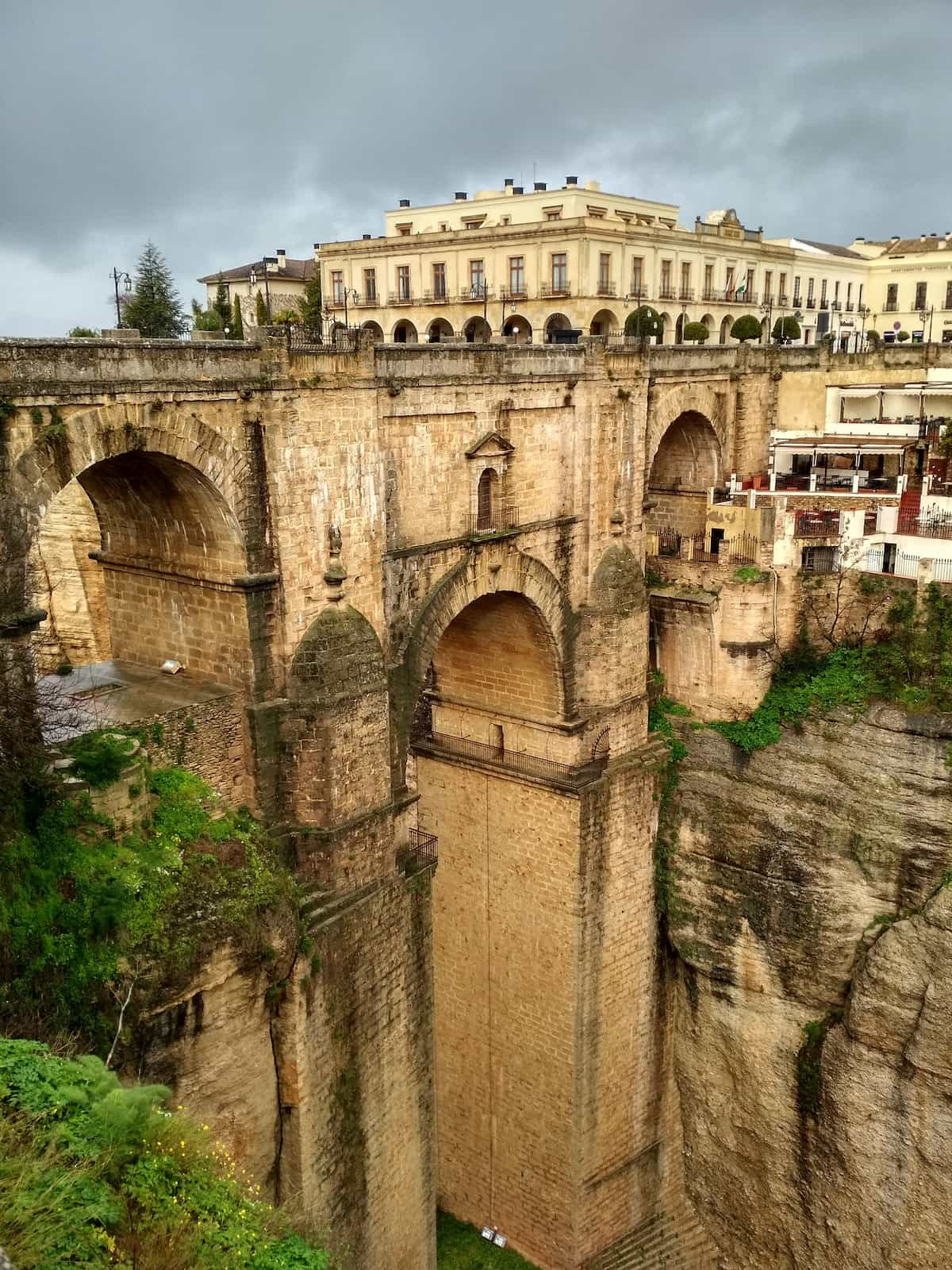Situated 700 meters above sea level in the beautiful natural scenery of Serrania de Ronda. This ancient inland city is without doubt a place to visit because of its huge historical heritage ranging from prehistoric times, the Romans and Arabs to this day. Ronda has so much to offer that you even can plan a two-day visit to fully enjoy the huge monumental wealth.
We will recommend some of the most essential locations to enjoy this inland city without hurry. Remember that we can bring you there and back on the same day; transport is no excuse for not enjoying this jewel in Andalusia.
It does worh to spend a day trip to Ronda and enjoy walking through the ancient streets of the city; you will not regret.

New Bridge
One of the most important monuments of Ronda is the New Bridge located hundred meters above the Tajo Gorge. The New Bridge is not only a masterpiece of engineering built in the late eighteenth century but also has spectacular views.

The original construction dates back to 1735, but eventually collapsed probably due to a construction defect; the second bridge was begun in 1751 and opened in 1793.
Walking around the area you can see that the bridge has a room inside, what is it? In the past it was used as a prison, it was also used as an inn and nowadays it is a museum.
Casa del Gigante
It´s worth walking through the city with time and discovering the old Arab quarter. In the three districts of Ronda you can find a huge variety of buildings. Casa del Gigante is one of the best preserved houses of Moorish architecture with far older stone reliefs of Phoenician origin.

This private house dates from the end of the 13th century and was an important residence during the Muslim period. Later in the 19th century it was converted into a shelter for abandoned or orphaned children. It would return to private hands and eventually become a museum in the early 21st century, showing what Muslim life was like in the past.
Bullring
The Bullring of Ronda is one of the oldest and most monumental ones. In fact, Ronda is considered one of the cradles of modern bullfighting of the eighteenth century.

During the 16th century there were defensive needs which led to the creation of the Real Maestranza de Ronda; there they used to hold training sessions on horseback, which would eventually evolve into games with bulls to show the rider’s skill. In the 18th century the bullfighters would take over from the horsemen and throughout the century they would become more professional and become very popular; this popularity led to the need for enclosed areas to house the performance of the spectacle, from which the current Plaza de Toros de Ronda was born.
As a curiosity, in 1784, bullfighting festivities were already taking place even though the bullring was still unfinished. Today it also has a bullfighting museum, so if you have interest in the historical aspects of Ronda, you should not miss the opportunity to visit it.
Casa de Don Bosco
Another very interesting building for its location is Casa de Don Bosco; a modernist palace from the beginning of the twentieth century located on the cornice of the gorge in the heart of the historic city centre of Ronda. IT has a beautiful courtyard and gardens situated along the gorge with splendid views over the Sierra.

Juan Bosco was an Italian priest and writer who achieved great prestige as an educator of needy young people. He was the founder of the Salesian congregation, which is one of the largest Catholic groups in the world.
Despite its name, it was not Juan Bosco’s residence, but is a private property that was eventually ceded to the Salesian group during the 20th century. Inside you will find 19th century tapestries, a typical Ronda fireplace and gardens with spectacular views.
Arab Baths
The thirteenth century Arab baths in Ronda are in very well conditions; probably one of the best preserved in Spain from that age.

In the past there were as many as four Arab baths in the city, some of them right in the city centre. This bath is located near the river, which facilitated the entry of water.
More activities and places of interest in Ronda
In the Municipal Tourist Office (situated at Paseo Blas Infante, next to the Bullring) is available a City Pass including tickets to the Interpretation Centre of the New Bridge, Mondragon Palace, headquarters of the Municipal Archaeological Museum, Casa del Gigante, Arab Baths and Museum of Contemporary Painting.
After this long walk you will be certainly looking for the Gastronomy of Ronda. We recommend trying the culinary delights of the Serrania (a la Rondeña); with a variety of meats and seasonal products.
Natural areas in Ronda
Due to its proximity to the city centre is worth mentioning the urban park of Dehesa del Mercadillo. At this place you can not only enjoy a pine forest at a short distance from the city but also a beautiful view of the Tajo de Ronda.
22 kilometres from Ronda, in the town of Benaojan, is located the cave Cueva de la Pileta with an extraordinary collection of cave paintings. Open daily, from 10 am to 1 pm and 4 pm to 6 pm. Entry 8 €.
Finally we highlight the Sierra de las Nieves Natural Park; whose name is due to the fact that at its highest summit (Torrecilla, 2000 m) there is usually snow in winter. This beautiful area still hosts many white villages, ravines, forests and rivers and is even worth another trip.

Get now your transfer from Malaga airport to Ronda and visit to this unique city, you will love it!









